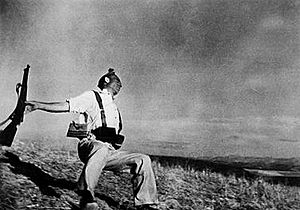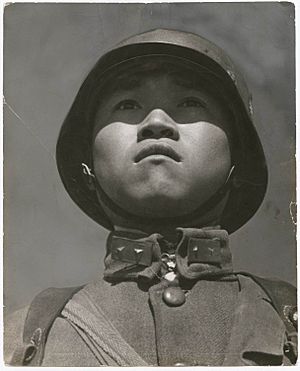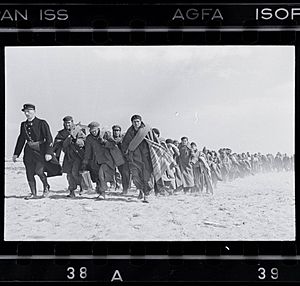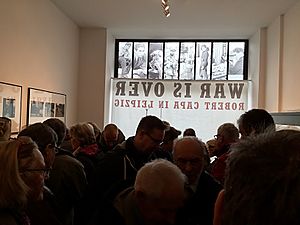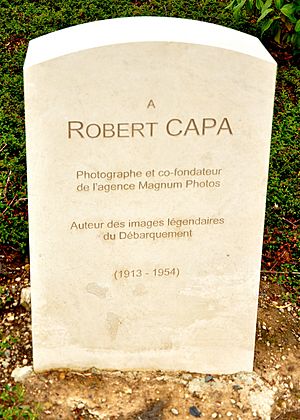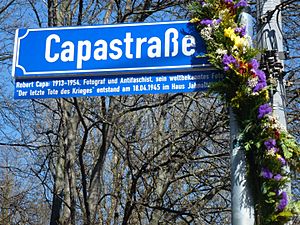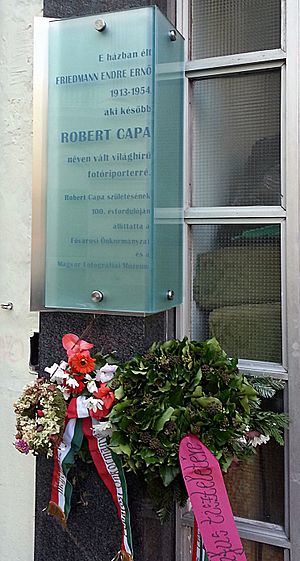Robert Capa facts for kids
Quick facts for kids
Robert Capa
|
|
|---|---|
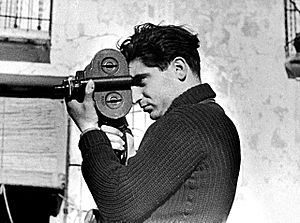
Capa on assignment in Spain, using a Eyemo 35 mm movie camera, photographed by Gerda Taro.
|
|
| Born |
Endre Ernő Friedmann
October 22, 1913 |
| Died | May 25, 1954 (aged 40) |
| Resting place | Amawalk Hill Cemetery, New York |
| Nationality | Hungarian, American (since 1946) |
| Known for | War photography |
Robert Capa (born Endre Ernő Friedmann; October 22, 1913 – May 25, 1954) was a Hungarian–American war photographer and photojournalist. Many people consider him one of the best combat photographers ever.
When he was a teenager, Capa left Hungary because of political problems. He moved to Berlin and went to college. He saw the rise of Adolf Hitler, which made him move to Paris. There, he met Gerda Taro, who became his photography partner. They started publishing their work.
Capa went on to cover five wars: the Spanish Civil War, the Second Sino-Japanese War, World War II in Europe, the 1948 Arab–Israeli War, and the First Indochina War. His photos appeared in major magazines and newspapers. He died in Vietnam when he stepped on a landmine.
During his career, he often risked his life. He was the only civilian photographer to land on Omaha Beach on D-Day. He took pictures of World War II in London, North Africa, Italy, and during the liberation of Paris. He was friends with famous people like Ernest Hemingway and John Steinbeck.
In 1947, U.S. general Dwight D. Eisenhower gave Capa the Medal of Freedom for his World War II photos. That same year, Capa helped start Magnum Photos in Paris. This was the first group for freelance photographers around the world. Hungary has honored him with a stamp and a gold coin.
Contents
- Early Life
- Photography Career
- Personal Life
- Legacy
- Politics
- Collections
- See also
Early Life
Capa was born Endre Ernő Friedmann in Budapest, Austria-Hungary, on October 22, 1913. His family was Jewish. When he was 18, he was accused of having communist ideas. He had to leave Hungary because of this.
He moved to Berlin and studied at Berlin University. He worked part-time helping in a darkroom and later became a photographer for a German agency called Dephot. During this time, the Nazi Party gained power. Because Capa was Jewish, he decided to leave Germany and move to Paris.
Photography Career
Capa's first photo was published in 1932. It showed Leon Trotsky giving a speech in Copenhagen.
After moving to Paris, he met Gerta Pohorylle, who later became Gerda Taro. She was also a German-Jewish photographer who had moved to Paris for similar reasons. They decided to work together using the name "Robert Capa." Later, they started publishing their work separately. Gerta created her own name, 'Gerda Taro'. Capa and Taro were also in a romantic relationship. Capa asked her to marry him, but she said no. They continued to work together. Capa also shared a darkroom with French photographer Henri Cartier-Bresson. They would later start the Magnum Photos group together.
Spanish Civil War (1936)
From 1936 to 1939, Capa worked in Spain. He photographed the Spanish Civil War with Taro and David Seymour.
During this war, Capa took his famous photo called The Falling Soldier (1936). It seems to show a Republican soldier dying. The photo was published in magazines like Life magazine and Picture Post. Later, some people wondered if the photo was real or staged. Picture Post once called Capa "the greatest war photographer in the world."
In 1937, Taro died in an accident. She was returning from a photo assignment covering the Battle of Brunete when her vehicle crashed with a tank.
Capa also went with journalist Ernest Hemingway to photograph the war. Hemingway later wrote about it in his novel, For Whom the Bell Tolls. Life magazine published an article about Hemingway's time in Spain with many of Capa's photos.
In 2007, three boxes of film rolls were found in Mexico. They contained 4,500 negatives from the Spanish Civil War by Capa, Taro, and Chim (David Seymour). These had been missing since 1939. In 2011, a film called The Mexican Suitcase was made about these images.
Chinese Resistance (1938)
In 1938, Capa traveled to Hankou, China (now part of Wuhan). He went there to document the resistance against the Japanese invasion. He sent his pictures to Life magazine, which published some of them on May 23, 1938.
World War II
When World War II began, Capa was in New York City. He had moved there from Paris to find work and to be safe. During the war, Capa was sent to different parts of Europe to take pictures. He first worked for Collier's Weekly and then for Life. He was the only "enemy alien" photographer working for the Allies. On October 7, 1943, Robert Capa was in Naples with a Life reporter. He photographed the 1943 Naples post office bombing.
D-Day, Omaha Beach (1944)
Capa took a famous group of photos known as "The Magnificent Eleven" on D-Day. He was with the 16th Infantry Regiment on Omaha Beach during the Allied invasion. The American soldiers faced very strong resistance from German troops.
Capa later said he took 106 pictures, but only 11 survived. Some believe his cameras got wet, or that a young assistant accidentally ruined most of the photos in the lab. However, this story has been questioned. In 2016, John G. Morris, who was a picture editor at Life in 1944, agreed that Capa likely took only 11 pictures on D-Day. These 11 photos were published in Life magazine on June 19, 1944. The captions were written by the magazine staff, as Capa did not provide notes.
The captions have since been shown to be wrong. For example, men described as hiding behind an obstacle were actually a demolition unit. They were tasked with clearing the way for landing crafts.
The Shaved Woman of Chartres
Capa took photos during the Allied invasion of France in 1944. His picture The Shaved Woman of Chartres, taken on August 16, 1944, shows a woman whose head was shaved. This was a punishment for working with the Nazis.
The Picture of the Last Man to Die
On April 18, 1945, Capa photographed a fight to secure a bridge in Leipzig, Germany. These pictures included an image of Raymond J. Bowman's death from a sniper. This photo was published in Life with the caption "The picture of the last man to die."
Post-war Soviet Union (1947)
In 1947, Capa traveled to the Soviet Union with his friend, the American writer John Steinbeck. They had met during World War II. Steinbeck told Capa he wanted to visit the Soviet Union after the war.
Capa suggested they go together and make a book. Capa would take photos of the war-torn country. Their trip resulted in Steinbeck's book, A Russian Journal. Photos were taken in Moscow, Kyiv, Tbilisi, Batumi, and among the ruins of Stalingrad. They remained good friends until Capa's death.
Magnum Photos Agency (1947)
In 1947, Capa helped start Magnum Photos in Paris. He founded it with Henri Cartier-Bresson, William Vandivert, David Seymour, and George Rodger. It was a group for freelance photographers to manage their work. It became known for its excellent photojournalists. In 1952, Capa became the president of Magnum Photos.
Founding of Israel (1948)
Capa visited Israel when it was being founded and attacked by neighboring countries. He took many photos that went with Irwin Shaw's book, Report on Israel.
Documenting Film Productions (1953)
In 1953, Capa joined screenwriter Truman Capote and director John Huston in Italy. Capa was assigned to photograph the making of the film, Beat the Devil. In their free time, they enjoyed playing poker with the movie's star, Humphrey Bogart.
First Indochina War and Death (1954)
In the early 1950s, Capa went to Japan for a Magnum Photos exhibition. While there, Life magazine asked him to go to Southeast Asia. The French had been fighting in the First Indochina War for eight years. Capa had said he was done with war, but he took the job. He went with a French regiment in Thái Bình Province with two Time-Life journalists. On May 25, 1954, the regiment was going through a dangerous area. Capa decided to leave his jeep and go up the road to take pictures. Capa was killed when he stepped on a landmine near the road.
He was 40 years old when he died. He is buried in Amawalk Hill Cemetery in New York, with his mother and his brother, Cornell Capa.
Personal Life
Capa was born into a middle-class Jewish family in Budapest. His parents were tailors. Capa's mother owned a successful fashion shop. Capa had two brothers: a younger brother, photographer Cornell Capa, and an older brother, László Friedmann. Cornell moved to Paris in 1936 to join Robert and became interested in photography.
At 18, Capa moved to Vienna, then Prague, and finally Berlin. These cities were centers for art and culture. He started studying journalism, but new rules prevented Jews from attending colleges. Capa moved to Paris and adopted the name 'Robert Capa' in 1934. He was already a hobby photographer by then.
In 1934, "André Friedman," as he was then called, met Gerda Pohorylle, a German Jewish refugee. They lived in Paris, and André taught Gerda photography. Together, they created the name "Robert Capa" as a famous American photographer. At the start of the war, both photographers published their work under this name. Gerda later took the name Gerda Taro and became successful on her own. She traveled with Capa to Spain in 1936 to photograph the Spanish Civil War. In July 1937, Capa went to Paris for a short time while Gerda stayed in Madrid. She was killed near Brunete during a battle. Capa was very sad about her death and never married.
In 1943, Capa met Elaine Justin. They fell in love, and their relationship lasted until the end of the war. Capa spent most of his time on the front lines. Capa called Elaine "Pinky" and wrote about her in his war book, Slightly Out of Focus. In 1945, Elaine Justin broke up with Capa.
Later, Capa became involved with the actress Ingrid Bergman. She was touring Europe to entertain American soldiers. In December 1945, Capa followed her to Hollywood. Their relationship ended in the summer of 1946.
Legacy
The government of Hungary issued a postage stamp in Capa's honor in 2013. That same year, they issued a 5,000-forint gold coin with his image.
His younger brother, Cornell Capa, also a photographer, worked to keep Robert's memory alive and promote his work. He also developed his own photography style. Cornell founded the International Fund for Concerned Photography in 1966. To give this collection a permanent home, he started the International Center of Photography in New York City in 1974. This was a major effort to preserve photography. Both Capa and his brother believed photography was very important and needed to be saved, much like films.
The Overseas Press Club created the Robert Capa Gold Medal in his honor.
Capa is known for changing how war photojournalism was done. He took pictures from the middle of the action, not from a distance. He famously said, "If your photographs aren't good enough, you're not close enough."
He is also credited with creating the term Generation X. He used it as a title for a photo-essay about young people growing up right after World War II. It was published in 1953. Capa said, "We named this unknown generation, The Generation X."
In 1947, U.S. general Dwight D. Eisenhower gave Capa the Medal of Freedom for his World War II photos. The International Center of Photography created a traveling exhibition called This Is War: Robert Capa at Work. It showed Capa's new ideas as a photojournalist in the 1930s and 1940s. It included old prints, contact sheets, notes, letters, and original magazine layouts from the Spanish Civil War, the Second Sino-Japanese War, and World War II.
In 1976, Capa was added to the International Photography Hall of Fame and Museum after his death.
Politics
As a young boy, Capa was interested in the Munkakör (Employment Circle). This was a group of socialist and modern artists, photographers, and thinkers in Budapest. He took part in protests against the Miklós Horthy government. In 1931, Capa was arrested by the Hungarian secret police. He was beaten and jailed for his political activities. A police official's wife knew his family and helped him get released. But he had to leave Hungary right away.
The Boston Review described Capa as "a leftist, and a democrat." He strongly supported the Loyalists and was against fascism. During the Spanish Civil War, Capa traveled with and photographed the Workers' Party of Marxist Unification (POUM). This led to his most famous photograph.
The British magazine Picture Post published his photos from Spain in the 1930s. They included a portrait of Capa with a simple description: "He is a passionate democrat, and he lives to take photographs."
Collections
- Art Institute of Chicago, Chicago, IL
- Metropolitan Museum of Art, New York
- Museum of Modern Art, New York
- Robert Capa: The Definitive Collection, Magnum Photos
- Robert Capa, International Center of Photography
- Robert Capa Photographs, Worcester Art Museum
- Robert Capa, The J. Paul Getty Museum
- Robert Capa, International Photography Hall of Fame
|
See also
 In Spanish: Robert Capa para niños
In Spanish: Robert Capa para niños


